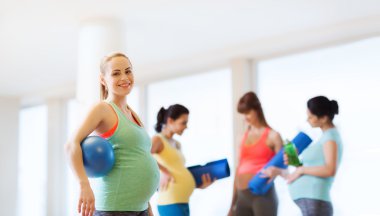
Should You Exercise During 1st Trimester (7 Useful Guidelines)
Should you exercise during 1st trimester? Understanding the benefits and precautions is crucial for maintaining a healthy pregnancy routine. In the whirlwind of excitement and anticipation that accompanies the news of pregnancy, one question often ignites a spirited debate among expecting mothers: should you exercise during the first trimester?
As the body embarks on the miraculous journey of creating new life, the notion of physical activity can evoke a spectrum of emotions—from apprehension to exhilaration. Yet, amid the flurry of advice and anecdotal accounts, a beacon of clarity is sought to illuminate the path toward optimal maternal health and well-being. Join to delve into the labyrinth of prenatal fitness, exploring the myths, the truths, and the invaluable benefits awaiting those who dare to lace up their sneakers and embrace the journey of exercise during the inaugural trimester of pregnancy.
Exercising during pregnancy is a topic of significant importance for expecting mothers. Many wonder about the safety and benefits of physical activity, especially during the delicate first trimester. Understanding the considerations and benefits can help expecting mothers make informed decisions about incorporating exercise into their routines during this crucial time.

Should You Exercise During 1st Trimester
Yes, exercising during the 1st trimester of pregnancy is generally safe and beneficial for both the mother and the baby.
Benefits of Exercise During the 1st Trimester
Engaging in regular physical activity during the first trimester can offer numerous benefits. It helps improve cardiovascular health, boosts mood, reduces the risk of gestational diabetes, and promotes better sleep quality. Additionally, exercise can alleviate common discomforts such as nausea and fatigue.
Safety Considerations
While exercise is generally safe during the first trimester, it’s essential to prioritize safety and listen to your body. Avoid high-impact activities, stay hydrated, and pay attention to warning signs such as dizziness or excessive fatigue. Consulting with a healthcare provider before starting or modifying an exercise routine is crucial.
Recommended Exercises
Low-impact exercises such as walking, swimming, prenatal yoga, and light strength training are generally safe and effective during the first trimester. These activities help maintain muscle strength, flexibility, and overall fitness without putting undue stress on the body.
Importance of Exercise During Pregnancy
General benefits of exercise during pregnancy
Exercise during pregnancy offers a myriad of benefits for both the expectant mother and her developing baby. Regular physical activity can help alleviate common discomforts such as backaches, swelling, and constipation by improving circulation and muscle strength. It also promotes better sleep and reduces stress and anxiety levels, fostering a healthier mental state throughout pregnancy.
Moreover, staying active can help maintain a healthy weight, which is beneficial for both the mother’s well-being and the baby’s development. Additionally, exercise during pregnancy can prepare the body for labor and delivery by enhancing endurance and flexibility. It may also reduce the risk of complications such as gestational diabetes and preeclampsia. Overall, incorporating safe and appropriate exercise into a pregnancy routine can contribute to a smoother, healthier pregnancy journey.

Potential risks of a sedentary lifestyle during pregnancy
During pregnancy, maintaining an active lifestyle is crucial for both the mother’s and baby’s health. However, a sedentary lifestyle during this time poses several potential risks. Firstly, it increases the likelihood of excessive weight gain, which can lead to complications such as gestational diabetes and high blood pressure. Additionally, being sedentary can contribute to the development of back pain, muscle stiffness, and poor posture, making the physical discomforts of pregnancy more pronounced.
Moreover, lack of physical activity may increase the risk of developing blood clots, as circulation slows down during periods of inactivity. Furthermore, a sedentary lifestyle can negatively impact mood and mental health, potentially leading to increased stress and anxiety levels. Overall, staying active during pregnancy is essential for maintaining both physical and mental well-being, and it’s important for expectant mothers to incorporate safe and suitable forms of exercise into their daily routines.
Overview of exercise guidelines for pregnant women
Exercise during pregnancy is not only safe but also highly beneficial for both the mother and the baby. The general guidelines for exercise during pregnancy recommend at least 150 minutes of moderate-intensity aerobic activity spread throughout the week. This could include activities such as walking, swimming, or stationary cycling.
Additionally, pregnant women should incorporate strength training exercises for major muscle groups on two or more days a week. However, it’s important to consult with a healthcare provider before starting any exercise program during pregnancy, especially if there are pre-existing medical conditions or concerns. Modifications may be necessary as pregnancy progresses, and it’s crucial to listen to your body and adjust accordingly. Overall, staying active during pregnancy can help improve mood, maintain physical fitness, and potentially ease the discomforts associated with pregnancy.
Understanding the 1st Trimester
Physiological changes during the 1st trimester
During the first trimester of pregnancy, the female body undergoes a multitude of physiological changes to accommodate the growing fetus. Hormonal shifts, particularly an increase in estrogen and progesterone levels, play a pivotal role in preparing the uterus for implantation and sustaining the pregnancy. These hormonal fluctuations can lead to symptoms such as nausea, breast tenderness, and fatigue.
The cardiovascular system experiences changes as blood volume increases to support the developing placenta and fetus, which can sometimes result in symptoms like dizziness and lightheadedness. Additionally, the uterus expands in size as the fetus grows, causing changes in the pelvic area and potentially leading to urinary frequency and mild cramping. Overall, the first trimester marks the beginning of a remarkable journey of physiological adaptations necessary for the nurturing and development of new life.
Common symptoms experienced during the 1st trimester
During the first trimester of pregnancy, many women experience a variety of common symptoms as their bodies undergo significant changes to accommodate the growing fetus. Nausea and vomiting, often referred to as morning sickness, are prevalent during this time and can occur at any time of day. Fatigue is also common due to hormonal shifts and the body’s increased energy demands.
Many women may notice breast tenderness and swelling as their bodies prepare for breastfeeding. Additionally, heightened sensitivity to certain smells and food aversions are typical during the first trimester. Some may also experience frequent urination as the uterus expands and presses against the bladder. While these symptoms can vary in intensity from woman to woman, they are often considered normal aspects of early pregnancy.
Impact of exercise on the developing fetus during the 1st trimester
During the first trimester of pregnancy, exercise can play a significant role in supporting the development of the fetus. While the initial weeks are critical for the formation of vital organs and systems, moderate exercise can contribute to improved maternal health, which in turn benefits the growing baby. Engaging in appropriate physical activity can help alleviate common discomforts such as nausea, fatigue, and constipation, thus promoting overall well-being.
Moreover, exercise enhances blood circulation, ensuring that essential nutrients and oxygen reach the placenta and the developing fetus efficiently. However, it’s crucial for expectant mothers to consult with healthcare providers to determine safe exercise routines tailored to their individual needs and medical history, as excessive or strenuous activity can pose risks to fetal development during this delicate stage. By maintaining a balanced approach to physical activity, mothers can positively influence the health and development of their unborn child during the first trimester.
Benefits of Exercising During the 1st Trimester
Physical benefits for the mother
Exercising during the first trimester of pregnancy offers numerous physical benefits for the mother. Regular physical activity can help alleviate common discomforts such as nausea, fatigue, and constipation, promoting overall well-being. It aids in maintaining a healthy weight and managing blood sugar levels, reducing the risk of gestational diabetes.
Strengthening the muscles, especially the pelvic floor, can ease labor and delivery while improving posture and reducing back pain. Additionally, exercise enhances cardiovascular health, ensuring better circulation and oxygen supply to both the mother and the developing fetus. Engaging in low-impact exercises like walking, swimming, or prenatal yoga can also contribute to better sleep quality and mood regulation, fostering a positive pregnancy experience.
Psychological benefits for the mother
Exercising during the first trimester of pregnancy can offer a plethora of psychological benefits for the mother. Not only does it help alleviate stress and anxiety by releasing endorphins, but it also fosters a sense of empowerment and control over her changing body. Engaging in physical activity promotes better sleep quality, which is often disrupted during pregnancy due to hormonal changes and discomfort.
Additionally, regular exercise during this crucial period can boost self-esteem and body image, as it aids in maintaining muscle tone and overall fitness. By incorporating exercise into her routine, a mother-to-be can cultivate a positive mindset, enhancing her mental well-being as she navigates the exciting journey of pregnancy.
Potential benefits for the developing fetus
For the developing fetus, maternal exercise can enhance blood flow to the placenta, promoting optimal oxygen and nutrient delivery essential for healthy growth and development. Moreover, research suggests that prenatal exercise may contribute to improved cardiovascular function and stress resilience in the offspring later in life. Therefore, incorporating safe and appropriate physical activity into the daily routine during the first trimester can provide enduring benefits for both mother and child.

Risks and Considerations
Potential risks of exercising during the 1st trimester
Exercising during the first trimester of pregnancy can carry potential risks that need to be carefully considered. One risk is the possibility of miscarriage, particularly if the exercise is strenuous or involves high-impact activities. Additionally, overexertion can lead to dehydration and overheating, which can be harmful to the developing fetus. Certain exercises, such as those involving heavy lifting or a high risk of falling, may also pose dangers. It’s crucial for pregnant women to consult with their healthcare provider before starting or continuing an exercise routine during the first trimester to ensure it’s appropriate for their individual circumstances and to minimize any potential risks.
Safety guidelines for exercising during the 1st trimester
During the first trimester of pregnancy, safety is paramount when it comes to exercise. It’s crucial to consult with a healthcare provider before starting any exercise regimen. Generally, low-impact activities like walking, swimming, or prenatal yoga are recommended. Avoiding activities with a high risk of falling or abdominal trauma is essential, so activities like contact sports, skiing, or horseback riding should be avoided.
Stay hydrated, wear comfortable clothing, and listen to your body. If you experience any pain, dizziness, or excessive fatigue, stop immediately and consult with your healthcare provider. Remember to warm up before exercising and cool down afterward, and always prioritize gentle movements that support your body and the well-being of your growing baby.
Types of Exercise Recommended During the 1st Trimester
Aerobic Exercises
During the first trimester of pregnancy, it’s crucial to engage in exercises that promote both physical health and the well-being of the growing baby. Aerobic exercises are highly recommended during this time as they help maintain cardiovascular fitness and improve circulation without placing undue stress on the body. Low-impact activities such as walking, swimming, and stationary cycling are excellent choices as they are gentle on the joints and reduce the risk of injury. These exercises also help alleviate common discomforts associated with early pregnancy such as nausea and fatigue.
Strength Training Exercises
During the first trimester of pregnancy, it’s crucial to prioritize exercises that support both the mother’s and baby’s health. While strength training can be beneficial, it’s essential to approach it with caution and focus on exercises that are safe and appropriate for this stage of pregnancy. Low-impact strength training exercises, such as bodyweight exercises, resistance band exercises, and light weightlifting with proper form, can help maintain muscle tone, improve posture, and alleviate some common discomforts associated with pregnancy. However, it’s essential to avoid exercises that put excessive strain on the abdomen or involve lying flat on the back for an extended period.
Flexibility Exercises
During the first trimester of pregnancy, flexibility exercises play a crucial role in promoting overall well-being and preparing the body for the changes ahead. Gentle stretching routines focused on improving flexibility in key muscle groups such as the back, hips, and legs can help alleviate discomfort and reduce the risk of common pregnancy-related ailments like back pain and muscle stiffness. Incorporating activities like prenatal yoga or Pilates can not only enhance flexibility but also promote relaxation and mindfulness, fostering a positive mindset during this transformative time.

Precautions and Modifications
General Precautions for Exercising During the 1st Trimester
Exercising during the first trimester of pregnancy requires careful attention to ensure the safety and well-being of both the mother and the developing baby. General precautions include consulting with a healthcare provider before starting any exercise regimen to assess individual health and risks. It’s crucial to choose low-impact activities that are gentle on the body, such as walking, swimming, or prenatal yoga, and to avoid contact sports or activities with a high risk of falling.
Staying hydrated and wearing appropriate clothing to prevent overheating is essential, along with listening to the body and stopping immediately if feeling dizzy, short of breath, or experiencing any pain. Additionally, maintaining good posture and avoiding exercises that involve lying flat on the back after the first trimester can help reduce the risk of complications. Always prioritize safety and listen to your body’s cues when exercising during the first trimester of pregnancy.
Modifications for Common Exercises
During the first trimester of pregnancy, modifications to common exercises are essential to ensure safety and comfort for both the mother and the developing baby. Adjusting intensity and duration is crucial, prioritizing consistency over intensity and opting for shorter durations to prevent overexertion. It’s advisable to avoid exercises that involve lying flat on the back after the first trimester, as this position can compress major blood vessels, potentially leading to dizziness or fainting.
Instead, focusing on exercises in a supported or elevated position can mitigate this risk. Incorporating proper breathing techniques is also key, emphasizing deep, controlled breaths to oxygenate the body and promote relaxation. Overall, these modifications help expectant mothers maintain a healthy fitness routine while safeguarding their well-being throughout the first trimester.
Frequently Asked Questions (FAQ) about Should You Exercise During 1st Trimester
Q1. Is it safe to exercise during the first trimester of pregnancy?
A. Yes, in most cases, it is safe to exercise during the first trimester. However, it’s essential to consult with your healthcare provider before starting any exercise routine.
Q2. What are the benefits of exercising during the first trimester?
A. Exercising during the first trimester can help reduce discomfort, improve mood, boost energy levels, promote better sleep, and potentially ease labor and delivery.
Q3. Are there any exercises I should avoid during the first trimester?
A. While many exercises are safe during the first trimester, it’s best to avoid activities with a high risk of falls or abdominal trauma. These may include contact sports, intense abdominal exercises, and activities with a high risk of impact.
Q4. How often should I exercise during the first trimester?
A. Aim for at least 30 minutes of moderate-intensity exercise on most days of the week, as recommended by the American College of Obstetricians and Gynecologists (ACOG).
Q5. What are some safe exercises for the first trimester?
A. Walking, swimming, stationary cycling, prenatal yoga, and low-impact aerobics are generally safe and beneficial during the first trimester.
Q6. Should I be concerned about overheating while exercising during the first trimester?
A. Yes, it’s essential to avoid overheating during exercise, especially during the first trimester. Stay hydrated, wear breathable clothing, and exercise in a well-ventilated area.
Q7. Can I continue my pre-pregnancy exercise routine during the first trimester?
A. In many cases, you can continue your pre-pregnancy exercise routine with modifications. However, it’s crucial to listen to your body and make adjustments as needed.
Q8. Are there any warning signs that I should stop exercising during the first trimester?
A. Stop exercising and consult your healthcare provider if you experience dizziness, faintness, shortness of breath, chest pain, vaginal bleeding, or fluid leaking from the vagina.
Q9. Is it safe to lift weights during the first trimester?
A. Yes, light to moderate weightlifting is generally safe during the first trimester, but it’s essential to use proper form, avoid heavy lifting, and listen to your body.
Q10. Can exercising during the first trimester harm the baby?
A. In most cases, exercising during the first trimester is safe and beneficial for both you and your baby. However, always consult with your healthcare provider before starting any exercise routine to ensure it’s appropriate for your individual circumstances.
Conclusion
In conclusion, the decision to exercise during the first trimester of pregnancy is a personal one that should be made in consultation with a healthcare provider. While exercise can offer numerous benefits, including improved mood, increased energy levels, and potential relief from common pregnancy discomforts, it’s crucial to prioritize safety and listen to your body’s signals. Moderate-intensity activities like walking, swimming, or prenatal yoga are generally safe for most pregnant individuals during this period.
However, it’s essential to avoid high-impact or contact sports and to modify exercises as needed to accommodate changes in your body. By staying informed, communicating openly with your healthcare provider, and practicing caution, expectant mothers can maintain a healthy level of physical activity throughout their pregnancy journey.